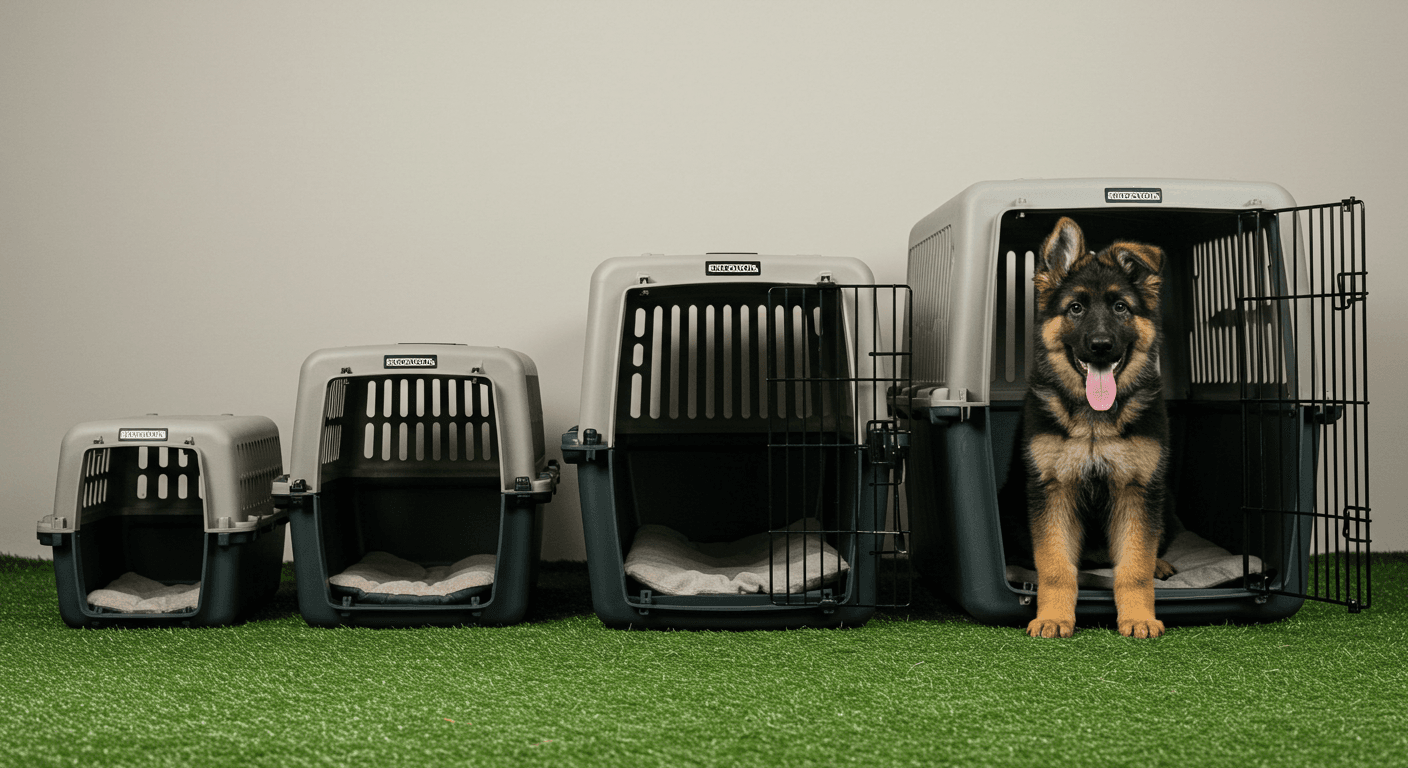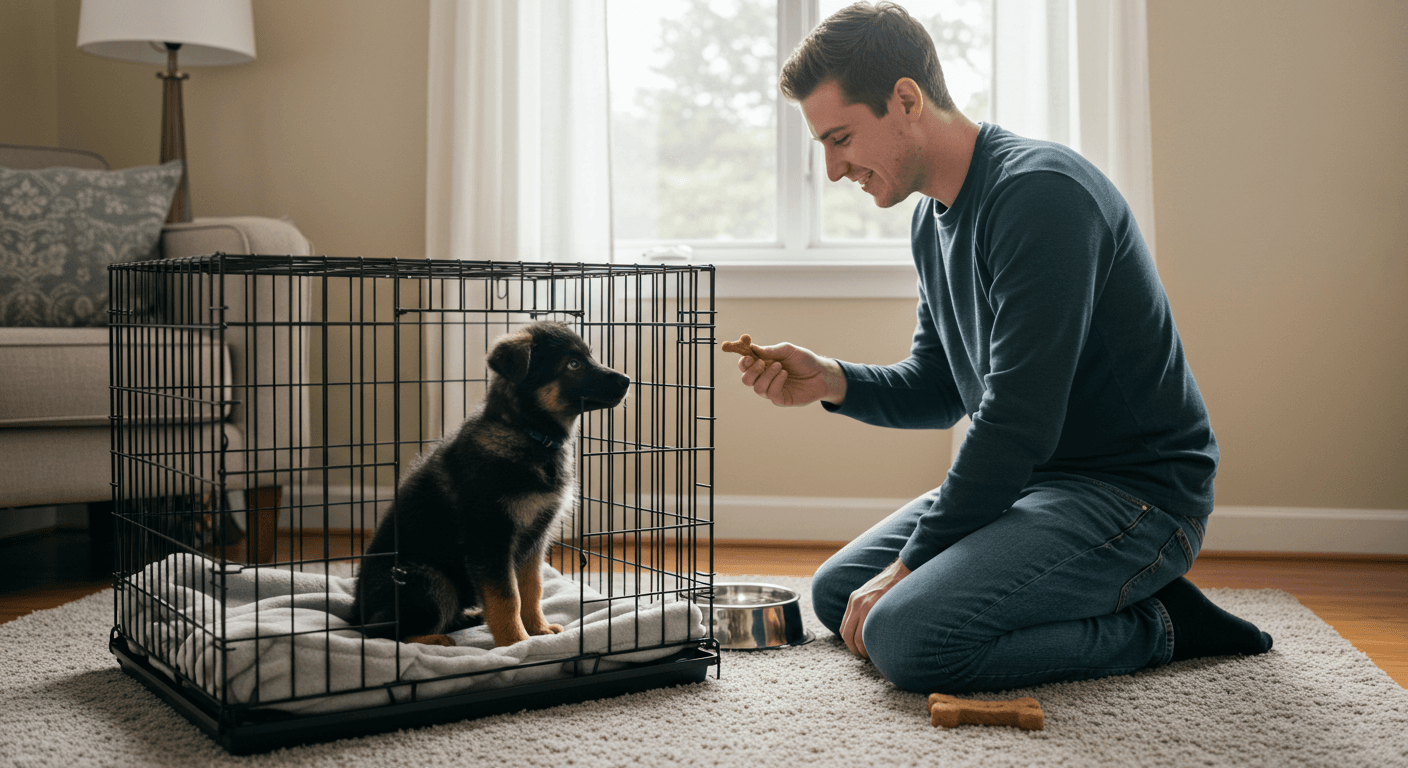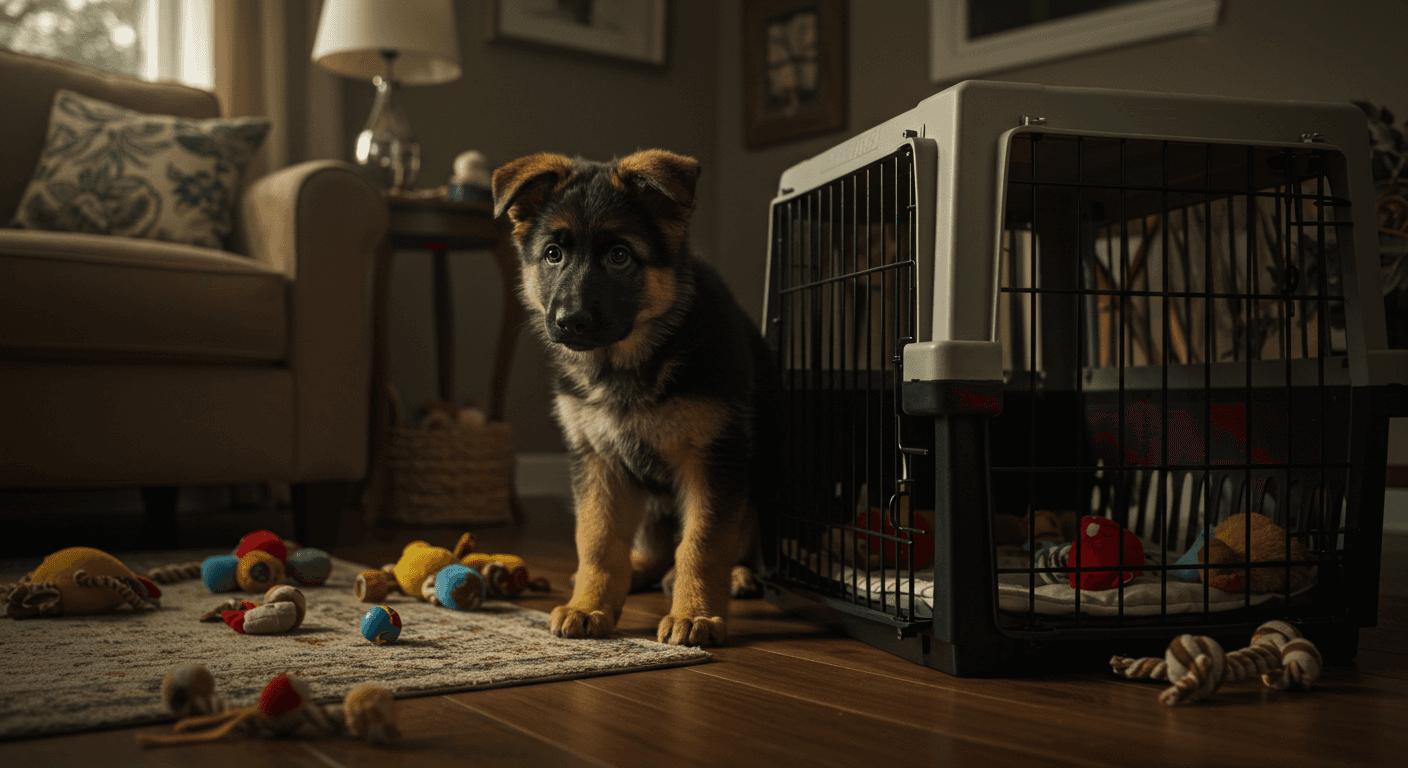Bringing home a German Shepherd puppy is exciting, but it also comes with a lot of responsibility. One of the most valuable tools for raising a happy, well-behaved dog is crate training. If you're wondering how to crate train a puppy, especially one as energetic and smart as a German Shepherd, you've come to the right place.
Crate training a puppy isn’t just about teaching them where to sleep. It's a helpful way to create a safe space for your dog, set up a routine, and prevent unwanted behaviors like chewing or potty accidents. For German Shepherds, who are known for their intelligence and loyalty, crate training can be both easy and rewarding when done right.
In this guide, we’ll walk you through everything you need to know about how to crate train puppy. From choosing the right crate to making it a cozy place your GSD loves, each step will help you build trust and create a positive experience for both you and your pup.
Whether you're new to crate training a puppy or just need some extra tips for your German Shepherd, this step-by-step guide will give you the tools and confidence to get started. Let’s make crate training simple, stress-free, and fun!
1. Choose the Right Dog Crate

Before you can start crate training a new puppy, you need the right crate. Picking the best dog crate for crate training is important, especially for German Shepherd owners. GSDs grow quickly, are full of energy, and need a space that feels safe not cramped.
Start with a crate that fits your puppy now but can grow with them. A crate with a divider is a smart choice. This way, your puppy won’t have too much space at first, but you won’t have to buy a new crate later. Remember, too much space can lead to accidents because it makes it easier for your pup to go potty in one corner and sleep in another.
German Shepherds are large breed dogs. So, make sure the crate is strong and has good airflow. Wire crates work great for this. They’re also easy to move and clean. If you need a quieter, more den-like space, consider a plastic crate. Just make sure it’s still the right size.
Place your crate in a quiet but social spot in your house. A living room corner is usually perfect. GSDs are loyal and love being close to their people. Finding the right spot for your dog crate in the house helps your puppy feel secure while still part of the family.
- Size matters – Choose a crate that your German Shepherd puppy can grow into
- Material – Wire crates for airflow, plastic for a den-like feel
- Portability – Look for foldable options if you move it often
- Dividers – A great way to adjust space as your puppy grows
- Comfort – Add a soft mat or blanket for a cozy den feel
Choosing the right dog crate sets the stage for success. Once your GSD sees the crate as a safe, cozy place, the rest of crate training becomes a lot easier!
2. Introduce the Crate Positively
Before your German Shepherd puppy can feel safe and happy in their crate, it’s important to make the crate a fun and friendly place. Crate training a puppy starts with the right introduction. Your pup should see the crate as a calm, cozy spot not a place for punishment.
Begin by placing the crate in a room where your family spends time, like the living room. Leave the door open and let your puppy explore it on their own. Don’t push or force them in. Instead, allow curiosity to guide them. This step will build trust and confidence right away exactly what your German Shepherd pup needs.
To make the crate more appealing, add a soft blanket and a favorite toy. You can even toss a few training treats inside to encourage your pup to go in. Each time they enter the crate, praise them with a happy voice and gentle petting. Positive reinforcement is the best way to crate train a puppy, especially one as smart and sensitive as a German Shepherd.
- Place the crate in a social area like the living room.
- Keep the door open to let your pup explore freely.
- Add comforts like soft bedding and toys.
- Use treats to encourage your pup to go inside.
- Always praise your German Shepherd when they interact with the crate.
Remember, crate training a puppy isn’t about locking them up it’s about giving them a safe space they love. With patience, consistency, and kindness, your German Shepherd will soon view the crate as their very own den.
3. Set a Consistent Puppy Crate Training Schedule
Creating a steady puppy crate training schedule is one of the most important steps in teaching your German Shepherd to love their crate. Puppies thrive on routine. Knowing when it's time to eat, play, rest, and go potty gives them confidence and helps them learn faster. A well-planned puppy crate schedule also helps reduce accidents in the house and supports crate training for potty training.
Start by building your schedule around your GSD pup’s needs. Puppies usually need to potty first thing in the morning, after meals, after playtime, and before bed. So those times should become your 'crate-out' points. Keeping these moments consistent helps your puppy understand what’s expected and when it will happen each day.
How To Crate Train German Shepherd Puppies
When you’re figuring out your puppy crate training schedule, try to include short and positive crate sessions during the day. These help your GSD associate the crate with rest and calm, not just sleeping at night. Puppies need naps throughout the day, so use crate time to give them a safe spot to unwind.
- Morning: Wake up and go outside right away for potty.
- Breakfast: After eating, wait 10–15 minutes, then go outside again.
- Midday Nap: A short crate rest after play or a walk.
- Afternoon: Potty break, play, and another brief crate break.
- Evening: Dinner, followed by potty and quiet play.
- Bedtime: Final potty trip, then overnight crating.
Try to follow this routine every day. A strong, steady puppy crate schedule teaches your German Shepherd when to expect crate time and makes learning faster and smoother. Over time, your pup will naturally adjust to the rhythm of the day.
If you're using crate training for potty training, timing is even more important. Keep track of your puppy’s potty cues and adjust the schedule as they grow. Puppies can only hold their bladder for a few hours, so don’t wait too long between breaks!
4. Start with Short Crate Sessions and Extend Gradually

When learning how to crate train a puppy, especially an active and smart breed like a German Shepherd, it's important to take things slow. Think of the crate as a cozy den where your puppy feels safe and happy not a place they fear. That’s why starting with short crate sessions is one of the best ways to help your puppy adjust to this new routine.
At first, let your German Shepherd puppy spend just a few minutes inside the crate. Keep the door open and toss in tasty treats or a favorite toy. Once your pup feels calm, you can close the door for a minute or two. If they stay relaxed, slowly add more time. The key here is gradual change. This helps build trust and reduces anxiety.
Now you may be wondering: how long should a puppy be in a crate? For young puppies under six months, they shouldn’t stay inside for more than 2-3 hours at a time during the day. Keep in mind that puppies need potty breaks often. As your German Shepherd grows, you can slightly extend this time. But always make sure they have enough bathroom, play, and cuddle time too.
If you're asking yourself how long can a puppy stay in a crate or how long can you leave a dog in a crate, the answer depends on your pup’s age and training level. For overnight, many puppies can handle 6–8 hours once they’re around 3–4 months old. Just be patient, pay attention to your pup’s signs, and adjust the routine as needed.
Remember, this training stage takes time, so celebrate small wins! Your German Shepherd will learn that the crate is a good place when you make it part of a positive, stress-free routine.
5. Master Crate Training Overnight
Helping your German Shepherd puppy sleep calmly in their crate through the night can feel like a big task. But don’t worry crate training a puppy overnight doesn’t have to be stressful. With a few smart steps, you can make nights smoother for both you and your pup.
Nighttime crate training is a little different from the daytime routine. Puppies, especially German Shepherds, may feel lonely, scared, or uncertain when left alone at night. That’s often when you hear puppy whining in crate at night, which can make you want to give up. But with some patience and the right setup, your pup can learn to settle down and snooze peacefully.
- Set up the crate in your bedroom. This helps your puppy feel safe knowing you’re nearby. It also makes nighttime potty trips easier.
- Give your puppy a potty break before bedtime. A tired and empty-bladder pup is more likely to sleep through the night.
- Use calming items inside the crate. Soft bedding, a favorite toy, or a crate-safe chew can help your puppy relax.
- Stick to a bedtime routine. Doing the same steps each night like a short walk, then crate time helps your puppy know what to expect.
- Avoid too much noise or light. A quiet, dark room signals sleep time and can reduce anxiety.
If your puppy starts crying or barking, try not to rush in right away. Wait a few minutes to see if they settle down. If the whining continues, take them out for a quick potty break don’t play, just do business and then gently return them to the crate.
Learning how to crate train puppy overnight takes time, but with consistency, your German Shepherd will catch on. Kennel training a puppy at night is one of the best ways to build trust and create healthy sleep habits that last.
6. Learn to Handle Separation Anxiety
Separation anxiety can be tough for both you and your German Shepherd puppy. These loyal dogs form strong bonds and don’t like being left alone. That’s why crate training a dog needs to go hand in hand with teaching them it's okay to be alone sometimes.
One of the keys to a successful puppy crate training schedule is making the crate feel safe and comfortable. If your puppy sees their crate as a happy space, they’re less likely to panic when you leave the room or house. Add soft bedding, favorite toys, or a shirt that smells like you to make it cozy and familiar.
Start slow. Leave your puppy in the crate for just a few minutes while you’re in another room. Come back calmly so your pup learns that being in the crate doesn’t mean you’re leaving forever. Over time, you can increase how long you step away.
If you’re crate training an older puppy, the steps are similar. However, older pups might already have established fears or habits. You'll need to be extra patient. Give them plenty of praise and treats when they stay calm and don’t make a big deal when you leave or return.
Also, avoid using the crate as a punishment. Doing so can make your German Shepherd more anxious about being inside it. The goal is to help your dog feel confident and calm while crated even when you’re not there.
- Create Positive Associations: Use treats and a happy voice when guiding your pup into the crate.
- Practice Short Absences: Leave the room briefly and gradually increase time apart.
- Keep Goodbyes Low-Key: Don’t make leaving a big event to avoid raising anxiety.
- Stick to a Routine: A regular puppy crate training schedule offers structure and security.
7. Avoid Common Crate Training Mistakes

Crate training a new puppy may seem simple, but there are some common mistakes that can slow down progress or even make your puppy fear the crate. As a German Shepherd owner, it’s important to be patient and thoughtful throughout the crate training process. Avoiding common mistakes early can make a big difference in helping your puppy feel safe, calm, and confident in their crate.
Here are a few of the most frequent crate training mistakes puppy parents make and how to avoid them. These tips are especially helpful when learning how to crate train a puppy in a way that builds trust and sets up long-term success.
- Using the crate for punishment: Never use the crate as a time-out spot. Your puppy should think of the crate as a cozy, safe place not a scary one.
- Leaving your puppy inside too long: German Shepherds are smart, but young pups have small bladders. Keeping them crated too long can cause stress and bathroom accidents.
- Skipping crate introductions: Tossing your puppy into the crate without slowly introducing it can create fear. Let them sniff, explore, and get used to the crate first.
- Inconsistency with rules: Letting your puppy sleep in bed one night and in the crate the next sends mixed signals. Be consistent with crate rules.
- Not making the crate comfortable: If the crate is too cold, hard, or bare, your puppy won’t enjoy being there. Add a soft blanket and a favorite toy to make it cozy.
Avoiding these mistakes will not only help with crate training a new puppy, but it will also strengthen the bond between you and your German Shepherd. Stick with a calm routine, use lots of praise, and stay patient. Before you know it, the crate will become a happy place your pup loves to be in.
8. Troubleshooting: If Your Puppy Still Hates the Crate

So, you've tried your best to follow the crate training steps, but your German Shepherd puppy still isn’t a fan of the crate. Don’t worry you’re not alone. Troubleshooting crate training challenges is a normal part of learning how to crate train your puppy in 3 days or even longer.
Some puppies, especially intelligent breeds like German Shepherds, need a little more patience and creativity. If crate training an older puppy or a spirited young GSD, you might hit a few bumps. But with the right tweaks, you can turn the crate from a dreaded space into a cozy retreat.
- Check crate comfort: Make sure the crate has a soft bed, a favorite toy, and isn't too hot or cold. A cozy crate feels safe.
- Avoid negative associations: Never use the crate as a punishment. It should be a happy and peaceful place only.
- Start over with short sessions: If your puppy’s resisting hard, go back to basics. Start with 5-minute crate stays and reward with treats.
- Limit crate time: Watch how long your puppy is crated. Wondering how long does it take to crate train a puppy? It varies, and too much time can cause stress.
- Try feeding in the crate: Serve meals inside the crate so your puppy links it with something good.
- Use calm departure cues: Don’t make a big deal about leaving or coming back. Quiet entries and exits help reduce anxiety.
- Exercise before crate time: A tired puppy is a relaxed puppy. Play and walk before crating.
Crate training doesn’t always follow a perfect schedule. While learning how to crate train your puppy in 3 days helps many owners, some German Shepherds need more time. Adjust as needed and stay positive. With patience and consistency, crate time will become calm time.
Crate training plays a big role in helping your German Shepherd puppy feel safe, calm, and well-behaved. After reading through these 10 essential tips, you now know how to crate train a puppy in a positive and loving way. This journey takes patience and consistency, but the results will give both you and your dog peace of mind.
Your pup’s crate should be their happy place not a punishment spot. With the right training, your German Shepherd will learn that the crate is their quiet zone to relax and recharge. It helps with potty training, keeps them safe when you’re gone, and gives them a cozy den of their own.
By sticking to a routine and using lots of praise, you’re teaching your puppy an important life skill. Every dog is different, so don’t worry if it takes a little time. Keep watching your pup’s behavior and make changes if needed.
If you’re just starting crate training a puppy, remember to stay calm, be clear, and keep things positive. This builds trust and makes learning easier for both of you. As your German Shepherd grows, the training you do now will make a big difference later.
Want more support? Keep reading trusted guides about crate training a dog and check in with your vet if you have questions. You’ve got this and your German Shepherd is lucky to have you!



